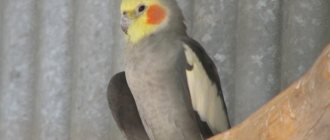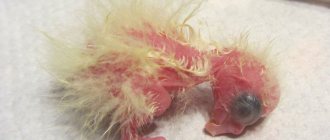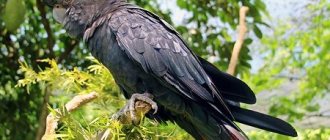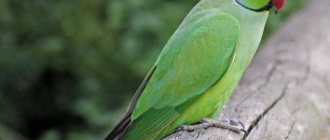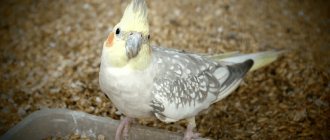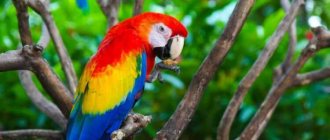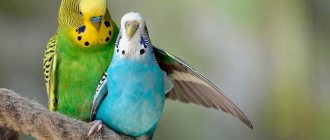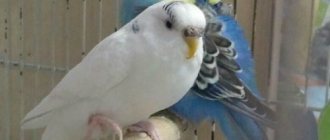The intricacies of breeding cockatiels are not known to everyone, and therefore novice breeders often experience failure. To deal with this issue, it is necessary to prepare well and study the behavioral characteristics of parrots and their needs.
We will learn how to properly prepare for mating birds, not make a mistake in choosing a male and female, and correctly organize the breeding of cockatiels.
general description
A medium-sized parrot from the Cockatoo family weighs 100 g. The body size is about 30 cm, the tail length reaches 15 cm, the wingspan is 40 cm. The beak is small, but quite powerful. A distinctive feature of cockatiels is a high crest on the head.
Natural coloring is not very bright; males look somewhat more colorful than females. Chicks at a young age have the same faded coloring as females. Only when they reach the age of puberty do males acquire their characteristic plumage. Usually changes begin to occur from 6 months of age.
Corellas reproduce well in captivity; artificially bred parrots have a wide variety of plumage color options. The most common mutation is lutino. Individuals of this species are yellow in color. They have red eyes and orange cheeks.
Cockatiels live only in Australia. These birds are monogamous. Their breeding season coincides with the rainy season and lasts from October to December. Parrots make their nest in the hollow of a dead tree at a height of 2 m above the ground. The female lays 4 to 7 eggs, one egg per day.
Both parents are equally involved in incubating eggs and feeding chicks. The chicks hatch after 17-23 days and are completely helpless. After 5 weeks, the chicks leave the nest. They reach puberty at 6-11 months.
In the wild, cockatiels live 12-15 years. If kept at home, a parrot can reach the age of 25 years with proper care.
Selecting a pair of cockatiels for mating
Good offspring of cockatiels can only be obtained if both parents are completely healthy, sufficiently mature, and are not close relatives to each other.
Appearance and health
First of all, the selected pair of parrots must have excellent physical and mental health. When purchasing, it is important to pay attention to the external condition of the birds - they should be cheerful, react with curiosity to strangers and to the entire environment in general.
You will probably be interested in reading about how to determine the age and sex of a cockatiel parrot.
Even if there are no visible diseases or injuries (apathy, weakness, inexplicable aggression), the future owner should still be on the safe side - after purchasing, take the new pets to the nearest veterinary laboratory for special avian tests confirming the absence of any inflammatory processes in the body of the cockatiel.
Age
Another important factor is the age of the cockatiel. Despite the fact that these birds are physically capable of breeding from the age of 6 months, it is extremely undesirable for them to breed offspring before the age of one and a half years.
Did you know? Of all the countless species of birds, only parrots can absorb food while holding it in their paws.
Otherwise, young males may simply be infertile, and young females may have problems laying eggs. Unlike the chicks of adult parrots, the offspring of immature young are born weakened and very rarely survive due to the lack of maternal instinct and basic care skills in inexperienced parents.
Not related
Breeding closely related cockatiels (inbreeding) will also be a big mistake. The consequences of such an experiment will probably be the most unexpected and will have an extremely negative impact on future chicks:
- various deformations of the beak, claws, paws, wings;
- painful orthopedic problems;
- impaired functioning of internal organs;
- infertility;
- weak immune system and high susceptibility to diseases.
Check out the common colors of cockatiels.
Features of behavior
When planning to breed cockatiels at home, pay attention to the behavioral characteristics of these parrots. The emotions they experience are clearly demonstrated by the parts of the bird’s body:
- Excitement, alertness - the crest stands upright, eyes wide open.
- Aggression, preparation for an attack - the crest is slightly tilted and pressed to the head, the pupils are dilated, the feathers are ruffled, the tail is loose. The bird clicks its beak and flaps its wings.
- Playfulness - the crest is held straight, lightly touching the back, eyes narrowed.
Parrots have a harsh and unpleasant voice. The more excited the bird is, the higher the voice.
If a cockatiel hisses, it is a sign that it is preparing to attack. A parrot reacts this way if it believes that an attempt is being made to take over its home. You should not stick your fingers between the bars; cockatiel bites are very painful.
Corella is sensitive to affection. She enjoys scratching her head and ruffling the feathers on the back of her head.
Cockatiels are shy. When experiencing stress, untamed parrots can become aggressive when given a new owner. It is better to buy birds from a nursery or from trusted breeders. It is not recommended to adopt an adult, unsocialized bird: it will not be able to get used to its owner and will cause him a lot of trouble.
Cockatiel nesting house
Any room for parrots of this species can be selected, the main thing is that the temperature regime is maintained and the appropriate humidity is maintained. Cages and houses must be equipped in such a way that cleaning and disinfection are easy. The presence of ventilation is desirable, but you can simply ventilate the room every day by opening the window. In this case, it is better to cover the cage with a special cover or take it to another room. The slightest hypothermia of the eggs will lead to the death of the embryos.
You will also have to think about a place for flying. Future parents should not sit locked up all the time; this will negatively affect their emotional state. Cages will imitate nests; these are wooden boxes. Only 3 walls are made of wood, the main one is made of mesh, and a door is thought out for the birds to escape. Sawdust, straw or sand are placed at the bottom (layer width 4 cm). To prevent microbes or parasites from appearing in the bedding, add chamomile to it. In nature, these parrots live in dry hollows; in pet stores you can find artificially created wooden houses. It is important to think about the roof of the tub; it should open easily, so you can watch the future chicks without unnecessary noise. Inexperienced bird lovers build nesting houses that are too large, but in a large space the chick can get separated from its mother and freeze.
Houses with cockatiels are cleaned regularly; dirt and droppings can lead to the development of diseases. If the female is weak, she will not be able to breed offspring and all efforts will be in vain. First, the female settles in the future nesting house; she must spend about a day in the new place. This way the bird will get comfortable and have time to look at everything, only then will the future father of her chicks move in with her. You need to carefully watch the cockatiels; if they like each other, the male will begin to court the female. He will sing, perform a mating dance and preen his feathers. Sometimes you have to be patient; mating can last from 7 days to 6 weeks.
Breeding
Breeding cockatiels is not difficult; As soon as parrots are 6 months old, they are already able to reproduce. But it is better not to subject a fragile organism to such a test and give the chicks the opportunity to grow up to one and a half years old.
In nature, parrots breed in the fall. At home, you can encourage cockatiels to mate by artificially creating suitable conditions for them; for this you need to:
- Find compatible partners.
- Ensure correct lighting conditions.
- Offer complete food.
- Place a nest in the cage.
It is advisable to purchase a spacious tall cage of rectangular or square shape. To breed a cockatiel at home, you need to provide a pair of parrots with a large cage, at least 70x70x150 cm.
Appearance and description of the cockatiel
Corella parrots are also called nymphs. These are small birds with a body length of 30 to 33 cm. They are distinguished from other parrots by a pointed tail 14-16 cm long and a bright tuft of feathers on the head.
The color of males and females differs, but the common feature is bright orange round spots on the cheeks and the absence of green. The crest, head and front part of the head are bright yellow, the wings are dark or light gray.
Color may change before reaching one year of age. After this, the parrots acquire their permanent color.
Compatibility issues
When a pair of opposite-sex cockatiels live together from a young age, and they have no alternative to meeting other partners, their friendships can gradually turn into marital ones. The resulting mutual interest will clearly manifest itself. The birds will sit side by side on a perch and gently touch each other’s feathers with their beaks. The male's readiness to mate is demonstrated by the increased intensity of his chants.
If your pet is raised alone and aggression occurs when a foreign parrot is introduced between the cockatiels, this may be due to increased testosterone levels in the male. A short separation usually solves this problem. If mutual hostility does not go away, you will have to take care of acquiring other marriage partners.
Adaptation to a new place
The place must be fully prepared at the time of move-in. You should not pull your cockatiel out of its carrier with your hands into its new home. Create a hallway by simply opening the carrier door and cage and placing them opposite each other. The bird must move from one place to another on its own.
It will take time to get used to your new home. This will take at least a day, and may take a week. The owner should under no circumstances disturb the parrot at this time. A new environment already frightens the animal, and excessive attention will only aggravate the cockatiel’s stressful state. After adapting to the place, you can establish contact with your pet.
What to feed
When breeding cockatiels at home, parrots are fed well-balanced food. A grain mixture for medium-sized parrots is suitable for this. Additionally, add to the diet:
- grated carrots;
- pieces of cabbage;
- slices of apple, pear;
- plantain seeds;
- dandelion leaves;
- a few drops of vegetable oil;
- sprouted grains;
- honey (2 g 1 time per week);
- boiled egg (2 - 3 times a week, a little).
Honey and butter can be given on a small piece of bread. Birds love to chew on fresh tree branches. The cage must contain special mineral supplements in the form of sand and pebbles.
After the birds settle into the nest for brooding, soft egg food should be excluded from their diet. Its presence stimulates the female to lay more eggs.
When the chicks hatch, the mashed egg becomes their main food and is returned to the feeder. Grown chicks, feeding on their own, switch to the regular diet of parrots.
Parents feed their babies by regurgitating food directly into their beaks. Chicks can be taken from their parents for artificial feeding when their eyes open. This usually happens on days 10–12. The “foster babies” are fed liquid warm porridge made from infant formula. You can also feed “natural animals” in order to accustom them to human hands.
Feeding the chicks
For three to four days, the female feeds the chicks with a yellowish-white liquid - chamois milk. After this time, the cockatiel begins to feed them with the male's semi-digested food.
If the birds, due to overwork and lack of parental instinct, do not start feeding the chicks, they will need help.
Feed your chicks baby formula every two hours. It should be liquid and heated to a temperature of thirty-five degrees. For convenience, use a syringe without a needle.
After a week, start feeding the chicks every three hours. When the baby is two weeks old, add well-prepared liquid millet porridge to baby food. Increase the amount of food you eat so you don't have to feed your children at night. When the chicks are a month old, start feeding them a tablespoon of grain mixture five to six times a day until they begin to eat on their own.
If you have raised cockatoos before, please share your experience with us. Perhaps you have something to add.
If you liked this article, please do.
Requirements for daylight hours
Long daylight hours stimulate parrots to reproduce; for cockatiels it should be at least 16 hours. Before this, the birds are kept on a shortened day for a month, its duration is 8 - 10 hours. During this period, parrots must undergo molting, their gonads are activated.
The required length of daylight can be ensured with the help of additional sources of artificial lighting and dense material thrown over the cage. The parrot needs to add more “day” gradually, 10 minutes every day. Too sudden a change in conditions can negatively affect his sexual function.
Comfortable indoor conditions for the breeding pair are maintained with a constant air temperature of 18–20 °C and a humidity of 50–60%.
Laying and incubating eggs
Immediately before mating, the behavior of the male changes noticeably - he becomes very affectionate, emits inviting calls, sings songs, taps his beak on the floor of the cage, minces and with spread wings courtes the female, invites her into the nesting house and tries in every possible way not to let her out.
The female begins to behave like the male: she spins around him and pecks at the perch. When there are other females in the cage, it can show aggression. The mating period does not last long, and after 8–10 days the first egg may appear in the nesting sawdust.
The next ones are postponed at intervals of 2-3 days. The maximum number of white eggs in a clutch is 5–6 pieces, rarely 7. Hatching is carried out by cockatiels one by one. Closer to the time the chicks appear, only the female is involved in the main process, and the male performs the functions of a guard and breadwinner.
Find out what to do if your cockatiel starts laying eggs.
Hatching time averages 20–23 days. During this period, it is very important to maintain optimal air temperature and humidity levels in the common room with the house.
Arrangement of the nest
A nest placed in a cage serves as a signal to encourage parrots to mate. This process usually takes about a week, but there may be exceptions. A special box is used as a nesting box; it can be bought in a store.
By the behavior of the parents, you can accurately determine when eggs will appear in the nest. The birds alternately perform the duties of a hen: during the day the male takes care of the eggs, at night the female replaces him at post. After 21 days from the moment of laying, the chicks will begin to appear.
Colors
Chicks and young individuals cannot boast of stable feather color; only after the first moult do parrots get their characteristic color. In the period from eight to twelve months, the nymph gradually replaces its feathers with permanent ones. The color of the bird directly depends on how the chick was bred: from the species of real cockatiels or as a result of crossing different subspecies.
Natural shades of feathers
Cockatiels need the natural color scheme of their plumage for camouflage, which is why free birds are so simply colored. The most common natural color is gray feathers and a yellowish head with orange spots on the cheeks. The outer surface of the wings is brown with white patches, the tips are black. The belly is light gray. The crest has the same color as on the main part of the head.
Differences between male and female
Cockatiels of different sexes differ from each other in some nuances of coloring and physique. Males are more expressive than females: boys have bright olive-colored feathers, their crest and head are sunny yellow. The cheeks are marked with round reddish spots. There are white mirrors on the wings. The flight and tail feathers have a bluish sheen.
Girls are a little lighter, even duller in appearance than boys. The lower part of the body is red, the yellow color of the crest is diluted with an admixture of gray feathers. The head is dirty yellow, the spots on the cheeks are brick brown. The inner side of the flight feathers is marked with yellow specks, the tail is marked with transverse black stripes. Typically, females have a wider tail than males.
Other color options
Gray (natural) color is not the only color for cockatiels. Breeders, by crossing birds carrying different genes, developed other species:
- Lyutino. Males and females are the same, their feathers are yellow, their cheeks are orange, and their eyes are red.
- Cinnamon. The plumage tone ranges from dark brown to coffee. In males the head is yellow, in females and chicks it is the same color as the body.
- Pearl, also called “pearl.” The feathers on the wings are yellow-white with black inclusions. There are pearl pearls: gray corella, lutino, cinnamon.
- Albino. White parrot with red eyes.
- Motley. The color of the feathers is uneven, there are bright circles on the cheeks.
- White-faced (no cheeks). The color can be anything except lutino. There are no spots on the cheeks.
Within each subgroup there can be combinations, depending on the dominant or recessive gene: white-faced variegated pearl barley, yellow-cheeked variegated pearl barley, pastel silver, steam variegated pearl barley.
